|
| |
Classification of the Planets and Their Physical Properties
The planets of the modern solar system are grouped into several different and sometimes overlapping classifications, as illustrated
here:
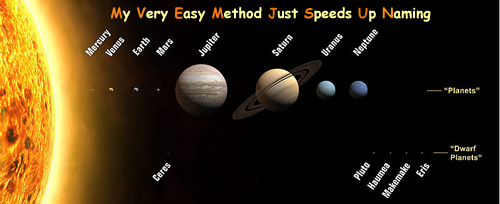
 | The planets inside the orbit of the earth are called the Inferior
Planets: Mercury and Venus. |
 | The planets outside the orbit of the earth are called the Superior
Planets: Mars, Jupiter, Saturn, Uranus, Neptune, and Pluto. |
 | The planets inside the asteroid belt are termed the Inner Planets (or the Terrestrial Planets): Mercury, Venus, Earth, and Mars. |
 | The planets outside the asteroid belt are termed the Outer
Planets: Jupiter, Saturn, Uranus, and Neptune. |
 | |
 | The planets sharing the gaseous structure of Jupiter are termed the Gas Giant (or
Jovian) Planets: Jupiter, Saturn, Uranus, and Neptune. |
 | Dwarf Planets |
The
Nine (8) Planets is an overview of the history, mythology, and current
scientific knowledge of each of the planets and moons in our solar system. Each
page has text and images, some have sounds and movies, most provide references
to additional related information.
Physical Properties of the Planets
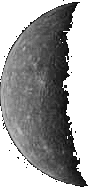 |
MERCURY
Distance from the Sun:
Mean: 57.9 million km (0.387 astronomical units)
Max: 69.7 million km (0.467 a.u.)
Min: 45.9 million km (0.306 a.u.)
Sidereal period: 87.969 days
Synodic period: 115.88 days
Rotation period: 58.6461 days
Mean orbital velocity: 47.87 km/s
Axial inclination:
Diameter: 4878 km
|
Surface area: 7.475
x 107
Density, water = 1:5.44
Mass: 3.3 x 1026 g
Mass, Earth = 1:0.055
Volume, Earth = 1:0.056
Escape velocity: 4.25 km/s
Surface gravity, Earth = 1:0.38
Mean surface temperature:
Day +350°C
Night -170°C
Extremes of surface temperature:
Day +427°C
Night -183°C
|
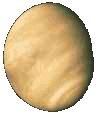 |
VENUS
Distance from the Sun:
Mean: 108.2 million km (0.723 a.u.)
Max: 109 million km (0.728 a.u.)
Min: 107.4 million km (0.718 a.u.)
Sidereal period: 224.701 days
Synodic period: 583.9 days
Rotation period: 243.16 days
Mean orbital velocity: 35.02 km/s
Axial inclination: 178 deg
Diameter: 12104 km
Density, water = 1:5.25
|
Mass: 4.870 x 1027
g
Mass, Earth = 1:0.815
Volume, Earth = 1: 0.86
Escape velocity: 10.36 km/s
Surface gravity, Earth = 1:0.903
Mean surface temperature:
Cloud tops -33°C
Surface +480°C |
 |
MARS
Distance from the Sun:
Mean: 227.94 million km (1.524 a.u.)
Max: 249.1 million km (1.666 a.u.)
Min: 206.7 million km (1.381 a.u.)
Sidereal period: 686.980 days
Synodic period: 779.9 days
Rotation period: 24 h 37 m 22.6 s
Mean orbital velocity: 24.1 km/s
Axial inclination: 23 deg 59 min
Diameter: 6794 km
Density, water = 1:3.94
|
Mass: 6.421 x 1026
g
Mass, Earth = 1:0.107
Volume, Earth = 1:0.150
Escape velocity: 5.03 km/s
Surface gravity, Earth = 1:0.380
Mean surface temperature: -23°C
|
 |
JUPITER
Distance from the Sun:
Mean: 778.34 million km (5.203 a.u.)
Max: 815.7 million km (5.455 a.u.)
Min: 740.9 million km (4.951 a.u.)
Sidereal period: 11.68 years
Synodic period: 398.9 days
Rotation period: 9 h 50 m 30 s
Mean orbital velocity: 13.06 km/s
Axial inclination: 3 deg 04 min
Diameter: 143884 km
Density, water = 1:1.33
|
Mass, Earth = 1:317.89
Volume, Earth = 1:1318.7
Escape velocity: 60.22 km/s
Surface gravity, Earth = 1:2.64
Mean surface temperature: -150°C |
 |
SATURN
Distance from the Sun:
Mean: 1427 million km (9.539 a.u.)
Max: 1507 million km (10.069 a.u.)
Min: 1347 million km (9.008 a.u.)
Sidereal period: 29.46 years
Mean synodic period: 378.1 days
Rotation period: 10 h 13 m 59 s
Mean orbital velocity: 9.6 km/s
Axial inclination: 26 deg 44 min
Diameter: 120536 km
Density, water = 1:0.71
|
Mass, Earth = 1:95.17
Volume, Earth = 1:744
Escape velocity: 32.26 km/s
Surface gravity, Earth = 1:1.16
Mean surface temperature: -180°C |
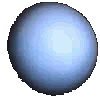 |
URANUS
Distance from the Sun:
Mean: 2869.6 million km (19.181 a.u.)
Max: 3004 million km (20.088 a.u.)
Min: 2735 million km (18.275 a.u.)
Sidereal period: 84.01 years
Synodic period: 369.7 days
Rotation period: 17.24 hours
Mean orbital velocity: 6.90 km/s
Axial inclination: 98 deg
Diameter: 51118 km
Density, water = 1:1.27
|
Mass, Earth = 1:14.6
Volume, Earth = 1:67
Escape velocity: 22.5 km/s
Surface gravity, Earth = 1:1.17
Mean surface temperature: -214°C |
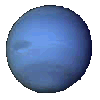 |
NEPTUNE
Distance from the Sun:
Mean: 4496.7 million km (30.058 a.u.)
Max: 4537 million km (30.316 a.u.)
Min: 4456 million km (29.800 a.u.)
Sidereal period: 164.8 years
Synodic period: 367.5 days
Rotation period: 16.1 hours
Mean orbital velocity: 5.42 km/s
Axial inclination: 28 deg 48 min
Diameter: 50538 km
Density, water = 1:2.0643
|
Mass, Earth = 1:17.2
Volume, Earth = 1:57
Escape velocity: 23.9 km/s
Surface gravity, Earth = 1:1.2
Mean surface temperature:
-220°C |
| Pluto: |
|
|
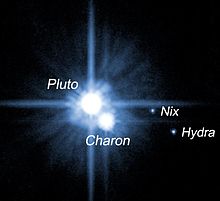 |
PLUTO (Dwarf Planet;
Trans-Neptunian Object; Plutoid; Kuiper Belt Object; Plutino)
Distance from the Sun:
Mean: 5900 million km (39.5 a.u.)
Max: 7375 million km (49.28 a.u.)
Min: 4425 million km (29.65 a.u.)
Sidereal period: 247.7 years
Synodic period: 366.7 days
Rotation period: 6 d 9 h 17 m 36 s
Mean orbital velocity: 4.7 km/s
Axial inclination: 122 deg .46
Diameter: 2324 km
Density, water = 1:2.03 |
Mass, Earth = 1:0.0022
Escape velocity: 1.18 km/s
Surface gravity, Earth = 1:0.06
Mean surface temperature: -230°C
Moons: Charon, Nix, Hydra, Styx, Kerberos
|
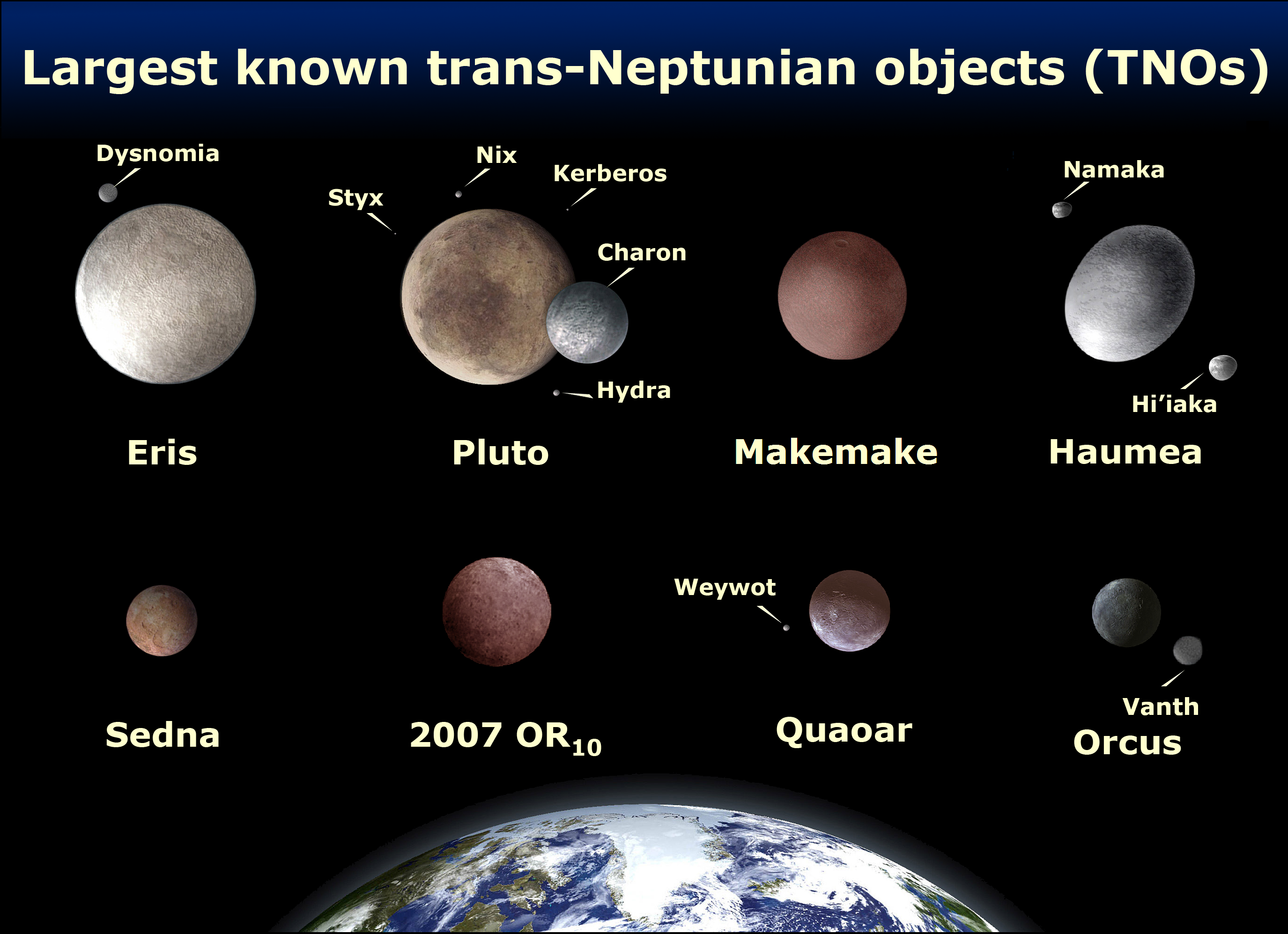
05/25/2015
|